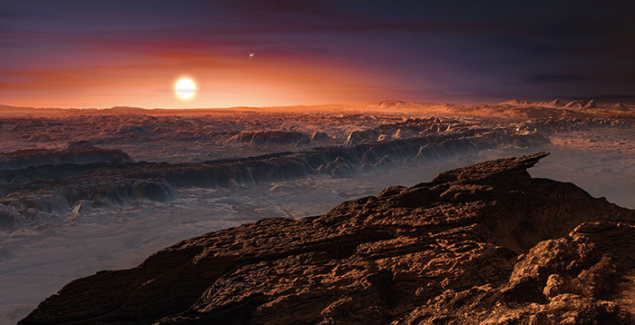
Image credit: ESO/M Kornmesser
Astronomers have found clear evidence of a planet orbiting the closest star to Earth, Proxima Centauri. The extrasolar planet is only slightly more massive than the Earth and orbits its star within the habitable zone, where the temperature would allow liquid water on its surface. The discovery represents a new milestone in the search for exoplanets that possibly harbour life.
Since the discovery of the first exoplanet in 1995, more than 3000 have been found. Most were detected either via radial velocity or transit techniques. The former relies on spectroscopic measurements of the weak back-and-forth wobbling of the star induced by the gravitational pull of the orbiting planet, while the latter method measures the slight drop in the star’s brightness due to the occultation of part of its surface when the planet passes in front of it.
Exoplanets discovered so far exhibit a diverse range of properties, with masses ranging from Earth-like values to several times the mass of Jupiter. Massive planets close to their parent star are the easiest to find: the first known exoplanet, called 51 Peg b, was a gaseous Jupiter-sized planet (a “hot Jupiter”) with a temperature of the order of 1000 °C due to its proximity to the star. The ultimate goal of exoplanet hunters is to find an Earth twin or at least an Earth-sized planet at the right distance from its parent star to have liquid water on its surface. This condition defines the habitable zone, which is the range of distance around the star that would be suitable for life.
Proxima Centauri b orbits the star (Proxima Centauri) in only 11.2 days and has a minimum mass of 1.27 Earth masses.
Proxima Centauri b matches this condition and is also a special planet for us because it orbits our nearest star, located just 4.2 light-years away. Near does not necessarily mean bright, however. Proxima Centauri is actually a cool red star that is much too dim to be seen with the naked eye and, with a mass about eight times smaller than the Sun, it is also around 600 times less luminous. The habitable zone around this red-dwarf star is therefore at much shorter distances than the corresponding distances in our solar system – equivalent to a small fraction of the orbit of Mercury. Proxima Centauri b orbits the star in only 11.2 days and has a minimum mass of 1.27 Earth masses. The exact value of the mass cannot be determined by the radial-velocity method because it depends on the unknown inclination of the orbit with respect to the line of sight.
During the first half of 2016, Proxima Centauri was regularly observed with the HARPS spectrograph on the ESO 3.6 m telescope at La Silla in Chile, and simultaneously monitored by other telescopes around the world. This campaign, which was led by Guillem Anglada-Escudé of Queen Mary University of London and shared publicly online as it happened, was called the Pale Red Dot.
The final results have now been published, concluding with a discussion on the habitability of the planet. Whether there is an atmosphere and liquid water on the surface is the subject of intense debate because red-dwarf stars can display quite violent behaviour. The main threats identified in the paper are tidal locking (for example, does the planet always present the same face to the star, as does our Moon?), strong stellar magnetic fields and strong flares with high ultraviolet and X-ray fluxes. Whereas robotic exploration is some time away, the future European Extremely Large Telescope (E-ELT) should be able to see the planet and probe its atmosphere spectroscopically.








